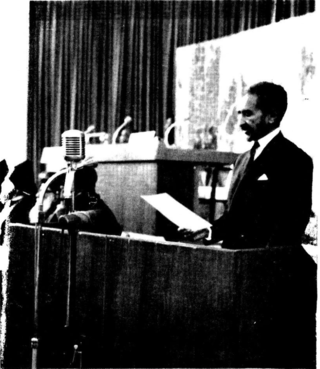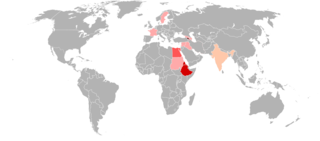
The Malankara Orthodox Syrian Church (MOSC) also known as the Indian Orthodox Church (IOC) or simply as the Malankara Church, is an autocephalous Oriental Orthodox church headquartered in Devalokam, near Kottayam, India. The church serves India's Saint Thomas Christian population. According to tradition, these communities originated in the missions of Thomas the Apostle in the 1st century. It employs the Malankara Rite, an Indian form of the West Syriac liturgical rite.

Patriarchate is an ecclesiological term in Christianity, designating the office and jurisdiction of an ecclesiastical patriarch. According to Christian tradition three patriarchates were established by the apostles as apostolic sees in the 1st century: Rome, Antioch, and Alexandria. Constantinople was added in the 4th century and Jerusalem in the 5th century. Eventually, together, these five were recognised as the pentarchy by the Council of Ephesus in 431.

A sacred language, holy language or liturgical language is any language that is cultivated and used primarily for religious reasons by people who speak another, primary language in their daily lives.
A catholicos is the head of certain churches in some Eastern Christian traditions. The title implies autocephaly and, in some cases, it is the title of the head of an autonomous church. The word comes from ancient Greek καθολικός, derived from καθ' ὅλου from κατά and ὅλος, meaning "concerning the whole, universal, general"; it originally designated a financial or civil office in the Roman Empire.

Alphabetical list of Eastern Christianity-related articles on English Wikipedia

Christianity in Ethiopia is the largest religion in the country, as 63% of the country, Islam follows behind. Christianity in Ethiopia dates back to the early medieval Kingdom of Aksum, when the King Ezana first adopted the faith in 4th century AD. This makes Ethiopia one of the first regions in the world to officially adopt Christianity.

Christianity has been, historically, a Middle Eastern religion with its origin in Judaism. Eastern Christianity refers collectively to the Christian traditions and churches which developed in the Middle East, Egypt, Asia Minor, the Far East, Balkans, Eastern Europe, Northeastern Africa and southern India over several centuries of religious antiquity. It is contrasted with Western Christianity, which developed in Western Europe. As a historical definition the term relates to the earliest Christian communities and their long-standing traditions that still exist.

Christianity, which originated in the Middle East during the 1st century AD, is a significant minority religion within the region, characterized by the diversity of its beliefs and traditions, compared to Christianity in other parts of the Old World. Christians now make up approximately 5% of the Middle Eastern population, down from 20% in the early 20th century. Cyprus is the only Christian majority country in the Middle East, with Christians forming between 76% and 78% of the country's total population, most of them adhering to Eastern Orthodox Christianity. Lebanon has the second highest proportion of Christians in the Middle East, around 40%, predominantly Maronites. Egypt has the next largest proportion of Christians, at around 10% of its total population. Copts, numbering around 10 million, constitute the single largest Christian community in the Middle East.

There is a very small community of Armenians in Ethiopia, primarily in the Ethiopian capital Addis Ababa. Armenians had traded with Ethiopia as far back as the first century AD.
Oriental Orthodoxy is the communion of Eastern Christian Churches that recognize only three ecumenical councils—the First Council of Nicaea, the First Council of Constantinople and the Council of Ephesus. They reject the dogmatic definitions of the Council of Chalcedon. Hence, these Churches are also called Old Oriental Churches or Non-Chalcedonian Churches.

The Oriental Orthodox Churches are Eastern Christian churches adhering to Miaphysite Christology, with approximately 60 million members worldwide. The Oriental Orthodox Churches are part of the Nicene Christian tradition, and represent one of its oldest branches.

The Conference of Addis Ababa was a meeting of the Oriental Orthodox Churches in Addis Ababa, Ethiopia from 15-21 January 1965. Hosted nominally by Abuna Basilios, but effectively by Abuna Theophilos, this meeting was momentous as there had been no such collective meeting of the various Non-Chalcedonian churches since the 5th century at Ephesus. The meeting was attended by Pope Cyril VI, Mor Ignatius Ya`qub III, Vazgen I, Khoren I, and Baselios Augen I.

Oriental Orthodoxy is the second largest Christian denomination in Iraq after the collective Eastern Catholic Churches. It includes the Syriac Orthodox Church, headed by a patriarch in Damascus, and the Armenian Apostolic Church, which serves the population of Armenians in Iraq. A sizable population have fled from Iraq following the US invasion and subsequent conflicts. Most Oriental Orthodox Christians are of ethnic Iraqi-Assyrian heritage, who make up about 500,000. The other significant minority of Oriental Orthodox Christians are ethnic Armenians. Christians are present in Baghdad, Basra, Mosul and northern Iraq.

Oriental Orthodoxy in Egypt represents Christians in Egypt who are adherents of Oriental Orthodoxy. In demographic terms, Oriental Orthodox Christians constitute the majority of Christians in Egypt.

Christianity is a prevalent religion in Denmark; in January 2020, 74.3% of the population of Denmark were members of the Church of Denmark. According to a survey based on a sample 1,114, 25% of Danes believe Jesus is the son of God, and 18% believe he is the saviour of the world. Aside from Lutheranism, there is a small Catholic minority, as well as small Protestant denominations such as the Baptist Union of Denmark and the Reformed Synod of Denmark.

Christianity in Cyprus is the largest religion in the country, making up 78% of the island's population. The largest Christian denomination is the Greek Orthodox Church, while the rest are smaller communities of Anglicans, Roman Catholics, Latin Christians, Maronites, Armenian Apostolics, and Greek Evangelicals.
Oriental Orthodoxy in the Republic of Ireland is part of the Oriental Orthodox Christian tradition. Before the beginning of the 20th century, the presence of Oriental Orthodox Christianity in Ireland was minor, gradually increasing only in the second half of the century with immigration, mainly from the region of Middle East and India. Today, it is a growing community, well integrated into Irish society.

Oriental Orthodoxy in North America represents adherents, religious communities, institutions and organizations of Oriental Orthodox Christianity in North America, including the United States, Canada, Mexico and other North American states. Oriental Orthodox Christians in North America are traditionally organized in accordance with their patrimonial ecclesiastical jurisdictions, with each community having its own structure of dioceses and parishes. Most Oriental Orthodox Christians in North America belong to Armenian, Coptic, Ethiopian, Eritrean, Indian, Syriac and some other communities, representing religious majority or minority within a particular community. Oriental Orthodox jurisdictions are organized within the Standing Conference of Oriental Orthodox Churches.

Oriental Orthodox Churches are the churches descended from those that rejected the Council of Chalcedon in 451. Despite the similar name, they are therefore a different branch of Christianity from the Eastern Orthodox. Oriental Orthodoxy consists of several autocephalous and autonomous jurisdictions holding a single set of beliefs and united in full communion. However, they each have their own separate rites, and there are significant differences between their respective practices. Thus, there is more internal diversity of practice among the Oriental Orthodox than among the Eastern Orthodox.
The Eastern Catholic Churches of the Catholic Church utilize liturgies originating in Eastern Christianity, distinguishing them from the majority of Catholic liturgies which are celebrated according to the Latin liturgical rites of the Latin Church. While some of these sui iuris churches are of the same liturgical ritual families as other Eastern Catholic churches and Eastern churches not in full communion with Rome, each church retains the right to institute its own canonical norms, liturgical books, and practices for the ritual celebration of the Eucharist, other sacraments, and canonical hours.














